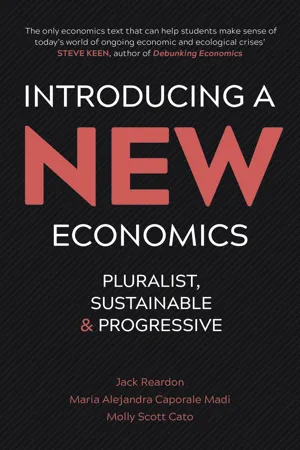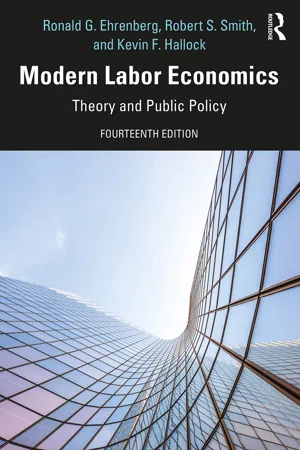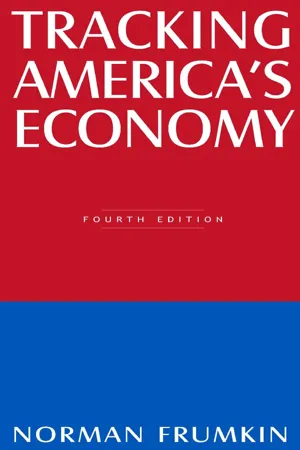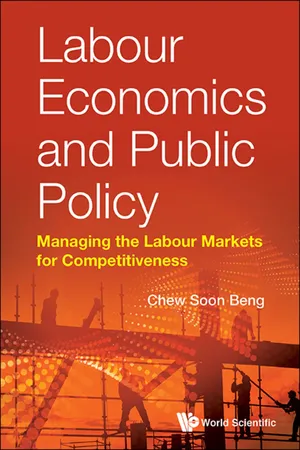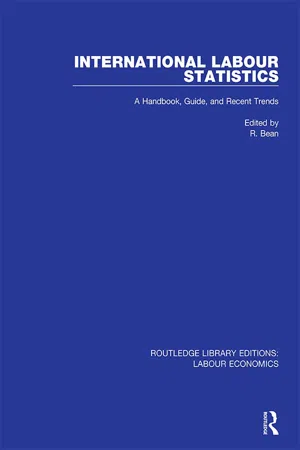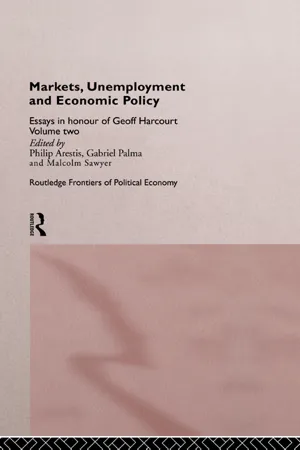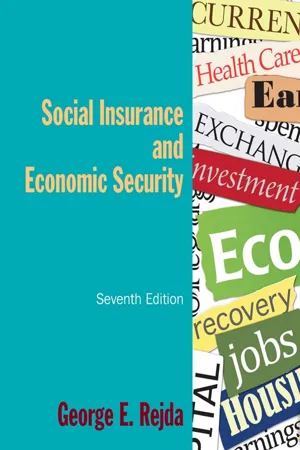Economics
Unemployment Rate
The unemployment rate is a measure of the percentage of the labor force that is without a job and actively seeking employment. It is a key indicator of the health of an economy, as high unemployment rates can indicate economic downturns and low rates can suggest a strong economy. Policymakers and economists use this data to assess the overall economic conditions and make informed decisions.
Written by Perlego with AI-assistance
Related key terms
Related key terms
1 of 4
Related key terms
1 of 3
10 Key excerpts on "Unemployment Rate"
- eBook - ePub
Introducing a New Economics
Pluralist, Sustainable and Progressive
- Jack Reardon, Maria Alejandra Caporale Madi, Molly Scott Cato(Authors)
- 2017(Publication Date)
- Pluto Press(Publisher)
The Unemployment Rate is the most visible and perhaps best-known barometer of the labour market. It generally increases during recessions and decreases during expansions; thus, typically, the longer the expansion, the lower the Unemployment Rate. The current global conceptual framework for measuring the labour force was officially adopted by the 13th International Conference of Labour Statisticians in 1982. Whether a person is categorised as unemployed is determined by a survey questionnaire asking about his or her activities during a specific reference point, e.g. a specific week during the previous month. The following are some commonly used definitions:• Working-age population, or economically active population: the total number of people aged 16 years and over.• Labour force: the number of people employed, plus the number unemployed from the working-age population, over the age of 16.• Labour force participation rate: the percentage of the working-age population who are members of the labour force; to obtain the rate, the latter is divided by the former.• Unemployed population: all persons who, during a specified week, had no job and were available for work and had made efforts to find employment.• Unemployment Rate: the percentage of people in the labour force who are unemployed. It is calculated by dividing the number of unemployed by the number of people in the labour force, then multiplying by 100. Question: If workers give up their search for work, what happens to the Unemployment Rate?• Vulnerable employment: - eBook - ePub
Modern Labor Economics
Theory and Public Policy
- Ronald Ehrenberg, Robert Smith, Kevin Hallock(Authors)
- 2021(Publication Date)
- Routledge(Publisher)
CHAPTER 14 UnemploymentWith the dramatic rise in unemployment in the Great Recession of 2007–2009 and then with the spike during the COVID-19 crisis has come a renewed interest in understanding both the measurement and—more importantly—the causes of unemployment. As noted in Chapter 2 , the population can be divided into those people who are in the labor force (L) and those who are not (N). The labor force consists of people who are employed (E) and those who are unemployed but would like to be employed (U). The concept of unemployment is somewhat ambiguous because, in theory, almost anyone would be willing to be employed in return for a generous-enough compensation package. Economists tend to resolve this dilemma by defining unemployment in terms of an individual’s willingness to be employed at some prevailing market wage. Government statistics take a more pragmatic approach, defining unemployed people as those who are on temporary layoff waiting to be recalled by their previous employer, or those without a job who have actively searched for work in the previous month (of course, “actively” is not precisely defined1 ).Given these definitions, the Unemployment Rate (u) is measured as the ratio of the number of unemployed people to the number people in the labor force:Much attention focuses on how the national Unemployment Rate varies over time and how Unemployment Rates vary across geographic areas and age/race/gender/ethnic groups.(14.1)u =U LHowever, Unemployment Rate data have limitations. They do reflect the proportion of a group that, at a point in time, actively want to work but are not employed. For a number of reasons, however, they do not necessarily provide an accurate reflection of the economic hardship that members of a group experience. First, individuals who are not actively searching for work, including those who searched unsuccessfully and then gave up, are not counted among unemployed people (see Chapter 7 ).2 - eBook - ePub
- Norman Frumkin(Author)
- 2015(Publication Date)
- Routledge(Publisher)
9Unemployment
Jobs directly affect the material well-being of workers and their families. To workers out of work, unemployment is not an abstract idea in a theoretical discussion. Thus, voters experiencing unemployment are more likely to vote for politicians who offer different perceptions of how the economy works with the promise of job creation, as noted by Alberto Alesina and Nouriel Roubini.1Unemployment also affects people and the economy in intangible ways, such as its influence on personal satisfaction and social stability. Though personal satisfaction and social stability are not strictly “economic,” they can affect economic developments (see chapter 14 , “Noneconomic Intangibles”).This chapter covers the official measures of unemployment based on household surveys of the civilian noninstitutional population sixteen years and older, the role of unemployment insurance, matching unemployed workers with job openings, cyclical movements of the labor force, and unemployment goals.UNEMPLOYMENT DATA
Unemployment data are prepared monthly by the Bureau of Labor Statistics (BLS) in the U.S. Department of Labor based on data obtained from a survey of a sample of households. The data series are published in the BLS monthly journals, Employment and Earnings and the Monthly Labor Review (www.bis.gov).The Unemployment Rate (UR) is defined as the percentage of the nation’s civilian noninstitutional labor force sixteen years and older that is out of work, actively looking for a job, and available for work. It is a relative measure of the degree of slack in job markets. At the most simple level, a relatively high UR indicates that production probably can be increased without generating inflation, because the available labor supply will tend to moderate wage rate increases and in some cases reduce wage rates. Conversely, in periods of low unemployment, high economic growth is more likely to raise wages—the tighter labor supply pushes up wages as more experienced and more productive workers are bid away from firm to firm on all steps of the skill ladder, which increases job openings for the less experienced and less productive workers. But the economy has not always conformed to this model (see chapter 2 - eBook - ePub
Labour Economics And Public Policy: Managing The Labour Markets For Competitiveness
Managing the Labour Markets for Competitiveness
- Soon Beng Chew(Author)
- 2017(Publication Date)
- WSPC(Publisher)
Chapter 13Employment and Unemployment
What is full employment and full employment output? How do economists look at unemployment? Is unemployment preventable or involuntary? This chapter will examine all these issues.Measures of Labour Market Participation
A jobseeker is an unemployed person. He fails to get a job at the prevailing wage and he still actively looks for a job. A person with a job is regarded as an employed person. He may work 10 hours a day. He may work three hours a day as a part time worker, but a part time worker is still considered being employed.Labour force is the sum of unemployment and employment. Employment rate is the ratio of employment over the labour force and unemployment is the ratio of unemployment over the labour force. Using this definition, we can conclude that the sum of employment rate and Unemployment Rate is equal to 100%.1Labour force participation rate is defined in terms of labour force over population. Female labour force participation rate is defined in terms of female labour force over female population. Female labour force participation rate in almost all countries have been rising as the purchasing power of wages declines.In the developing countries, they seldom use Unemployment Rate. Rather, they discuss in terms of labour utilization rate. The labour utilization rate which, has been dictated by the seasons is high during the harvest time.In many countries, they allow foreign workers to work. Those foreigners, who quality for more stringent criteria are given green cards or accepted as permanent residents, but they are not citizens. If we include foreign workers and permanent residents as part of the labour force, employment rate would be higher and Unemployment Rate would be lower compared to these measures strictly applicable to citizens. If we want to assess effectiveness of public policy in the labour markets, we should not include foreign workers and permanent residents in the measurement of employment and Unemployment Rates. - eBook - ePub
The Macroeconomic Environment of Business
Core Concepts and Curious Connections
- Maurice D Levi(Author)
- 2014(Publication Date)
- WSPC(Publisher)
Eq. (5.1) , (E + U), is the workforce, which consists of those working, plus those not working but looking for work.The full-time Unemployment Rate is the number of people without full-time work and actively seeking work divided by the workforce. The workforce consists of those with full-time work plus those not working but seeking full-time work.In the U.S., in addition to calculating the full-time Unemployment Rate for the entire nation, the data are analyzed to compute rates of unemployment for different geographical locations, for blacks versus whites, for males versus females and for heads of families versus others. Data are also maintained for part-time workers, and for those not working who have given up trying to find a job, the so-called discouraged workers. As with the national income and product account statistics, further adjustments are made for the season, with these adjustments based on an examination of average month-to-month variations in unemployment over a number of earlier years.Clearly, there are some difficulties with using the unemployment statistics as a precise measure of the unemployment problem. For example, people laid-off without any planned recall are not considered unemployed if they are waiting in hope of being taken back in their old job; they are not counted as unemployed because they are not actively looking for work. In a similar way, people who have been unemployed so long they have given up looking are not counted as being unemployed, although they are included separately in a discouraged worker category. Indeed, it is possible for the Unemployment Rate to decline when employment prospects are so bleak that there are more people who have given up looking. There are also difficulties introduced by part-time work that is being done because full-time jobs are not available; part-time workers are not counted in the full-time unemployment statistics, although statistics on part-time work are separately reported. - eBook - ePub
International Labour Statistics
A Handbook, Guide, and Recent Trends
- R. Bean(Author)
- 2018(Publication Date)
- Routledge(Publisher)
(3) In the application of the criterion of current availability for work, especially in situations covered by subparagraph (2) above, appropriate tests should be developed to suit national circumstances. Such tests may be based on notions such as present desire for work and previous work experience, willingness to take up work for wage or salary on locally prevailing terms, or readiness to undertake self-employment activity given the necessary resources and facilities.(4) Notwithstanding the criterion of seeking work embodied in the standard definition of unemployment, persons without work and currently available for work who had made arrangements to take up paid employment or undertake self-employment activity at a date subsequent to the reference period should be considered as unemployed.(5) Persons temporarily absent from their jobs with no formal job attachment who were currently available for work and seeking work should be regarded as unemployed in accordance with the standard definition of unemployment. Countries may, however, depending on national circumstances and policies, prefer to relax the seeking work criterion in the case of persons temporarily laid off. In such cases, persons temporarily laid off who were not seeking work but classified as unemployed should be identified as a separate subcategory.(6) Students, homemakers and others mainly engaged in non-economic activities during the reference period who satisfy the criteria laid down in subparagraphs (1) and (2) above should be regarded as unemployed on the same basis as other categories of unemployed persons and be identified separately, where possible.THE Unemployment RateIt is the rate of unemployment rather than the absolute number of people unemployed that indicates the severity of unemployment. In the introductory section the rate, u, was defined as U/L, where L = E + U. In principle, nothing could be simpler, the denominator is the total labour force size - sometimes referred to as the ‘economically active population’ -which can be decomposed into those employed (E) and those unemployed (U). In practice, not all countries - or rather, statistical agencies - agree on what should be included in the economically active population. As we shall see, concepts and methods of measuring U differ from one country to another. Likewise, there are differences in the measurement of E. Thus, even if all countries agreed on how to measure U, but disagreed on how to measure E, comparisons of Unemployment Rates would be distorted. - eBook - ePub
- Philip Arestis, Gabriel Palma, Malcolm Sawyer(Authors)
- 2005(Publication Date)
- Routledge(Publisher)
The Council of the Royal Statistical Society (RSS), concerned by the political controversy and evident lack of public confidence in the headline claimant count, and the possible implications for the professional integrity of its members working in the Government Statistical Service, established a Working Party on the Measurement of Unemployment in the UK, whose membership included the present and immediate past presidents of the RSS. Their report was published on 5 April 1995.The report begins with a number of useful thoughts about the issues involved in defining and then measuring unemployment.4Involuntary unemploymentThe Cambridge economist Pigou was the first, it seems,5 to introduce the term ‘involuntary unemployment’ in his 1914 volume Unemployment. He defined unemployment as the number of persons without paid work who would like to work in their customary occupation at the going rate for the job.The amount of unemployment … in any industry is measured by the number of hours’ work … by which the employment of the persons attached to or occupied in that industry falls short of the number of hours’ work that these persons would have been willing to provide at the current rate of wages under current conditions of employment.(1914: 16)The stress on current rate of wages reflected, it appears, the then National Insurance Act whereby a man was still treated as unemployed even if he refused to work at less than the going rate for the job. Equally, the reference to the ‘going rate’ ensures that those with unrealistic wage expectations are classed as ‘voluntarily’ unemployed. Pigou, in his 1933 book Theory of Unemployment - eBook - ePub
- Shafiq Dhanani, Iyanatul Islam, Anis Chowdhury(Authors)
- 2009(Publication Date)
- Routledge(Publisher)
Chapter 7 .Unemployment
Unemployment trends
The assessment of unemployment levels and trends is a tricky undertaking in Indonesia because the official definition of open unemployment underwent drastic revisions in 1994 and 2001. In both years, the changes set out to widen the scope of the labour force surveys, presumably to obtain a more comprehensive measure of under-utilization of labour in the economy. In the first case, the surveys included the openly unemployed who looked for work beyond the week prior to the survey. In the second case, they included people not actively looking for work but who were available for work. This legitimate concern has however led to much unnecessary confusion between the extent of open unemployment and the separate issue of discouraged unemployment and other forms of under-utilization of labour.Figure 3.1Open Unemployment Rates, 1976–2009, percentage of labour force (source: CBS (2008a), Sakernas annual labour force survey (Tables 6.1 and 36.2 in 2007).Notes 1 The official definition since 2001 includes persons preparing a business activity, and persons who had a job but had not started it yet. 2 2009: February round. Unless mentioned otherwise, the August publication used for all other years. February and August not directly comparable because of seasonality.When CBS initiated the annual national labour force survey in 1976, it adopted the widely used ILO definition of not working and looking for work during a well-defined period – in this case one week prior to the survey. Open unemployment remained relatively stable at around 2 per cent between 1976 and 1982, and around 3 per cent of the labour force in the period 1982 to 1994 (Figure 3.1 - eBook - ePub
- George E. Rejda(Author)
- 2015(Publication Date)
- Routledge(Publisher)
• The Unemployment Rate is the number of unemployed as a percentage of the civilian labor force; the labor force comprises all persons classified as employed or unemployed in the civilian noninstitutional population age 16 and over.• Widespread unemployment has certain economic costs: loss of the GDP that could have been produced; loss of millions of years of labor; and retardation of economic growth. Noneconomic costs include deterioration in work skills, lower self-esteem, and deterioration of family life.• The underemployed include workers employed below their actual or potential skill level, people outside the labor force seeking work, and involuntary part-time workers.• Groups with high Unemployment Rates, as of 2011, include blacks, Hispanics, Native Americans, teenagers, older workers, and high school dropouts.• Approaches for reducing unemployment include expansionary monetary and fiscal policy, unemployment compensation benefits, improved labor market information, employment and training programs, and federal tax credits to employers.• - Merijn Knibbe(Author)
- 2019(Publication Date)
- Routledge(Publisher)
Another strategy to un-see unemployment during the Great Depression can be found in Cole and Ohanian (2003). The problem Cole and Ohanian (2003) tries to solve is low growth of total hours after 1934. Despite an increase in productivity (which, according to the model, makes the representative consumer work more as production per hour is higher which will mean that more hours of leisure are traded for hours of work) 1939 production per capita was still way below the 1929 level and average hours were still low. The problem it does not try to solve is the decreasing but still high level of ‘measured unemployment’ throughout the 1930s. ‘Unemployment’ is only mentioned twice in the 50 pages of text and this only to debunk the concept of the statistic:Our model predicts the fraction of individuals in the market sector who search for a job. The number of searchers in our model, divided by the number who are either working or searching, is 11 percent during the early part of the transition, and then declines to about five percent. The Unemployment Rate is one empirical measure of the fraction of individuals searching. Measured unemployment fluctuated between 16 percent in 1934 to about 11 percent in 1939.It’s of course not the fraction of individuals but the fraction of the labor force, which consists of individuals. And considering the importance of workfare projects and government employment in general, employment was not just about the market sector. But aside of this: they totally redefine unemployment. I couldn’t find anything in the text which explains how the ‘searchers’ were measured or which empirical metric they use to derive their guesstimate – it seems to be just an artefact of their model. And they simply disregard the difference between (much higher) measured unemployment and their hypothetical ‘searchers’. It can be added that in 1932, unemployment was 23 percent, according to the source they use (Darby 1975) – quite a bit higher than the 16 percent of 1934, which means that workfare, going of gold and more expansive government strategies had solved part of the problem. They also state that in their models ‘Individuals work either full-time, or not at all’
Index pages curate the most relevant extracts from our library of academic textbooks. They’ve been created using an in-house natural language model (NLM), each adding context and meaning to key research topics.
Explore more topic indexes
Explore more topic indexes
1 of 6
Explore more topic indexes
1 of 4
